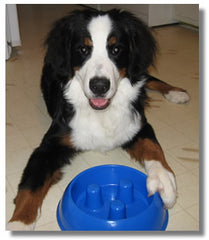Dog Breeds Most At Risk for Bloat
In the late stages of bloat, when shock is nearly certain, symptoms include rapid or labored breathing and heart rate, weak pulse, pale gums and tongue and weakness or collapse. If the dog is able to belch or vomit, it is more than likely that the issue is not bloat.
Gastric dilation volvulus (GDV), commonly known as “bloat,” is a life-threatening condition that can affect every breed of any age at any time. Bloat is the second most common cause of death in dogs, proving to be fatal in roughly 50% of cases. Though all dogs are susceptible to canine bloat, there are certain factors that can increase the risks significantly. Currently, only two treatments exist for bloat, and with no absolutely way to prevent it, knowing the canine bloat symptoms is a necessity.
Canine Bloat Symptoms
The most telling signs of bloat are restlessness, pacing, increased salivation, retching, unsuccessful vomiting attempts and an enlarged, sensitive abdomen that produces a hollow sound when thumped. There are, however, situations in which bloat is present, but no dog bloat symptoms are obvious. More subtle symptoms may occur in the early stages of bloat, such as lethargy, obvious discomfort, stiff movement, head-hanging and a slightly tight abdomen.

View Breeds with High Risk for Bloat
Gastric bloat in dogs is a threat to all breeds. There have been several factors linked to an increased chance of bloat in dogs occurring, which are large meals eaten at once, dry dog food high in grain, intense exercise before or after meals, drinking large amounts of water during meals, high energy levels, deep-chested breeds, the size of the dog, the dog’s age and dogs whose ancestors have had bloat at some point in time. It has been argued that the dog’s size and age are the most important things to consider when assessing bloat risk. Data suggests that the risk of bloat increases by 20% for large breeds after age 5 and 20% for giant breeds after age 3. After age 7, the risk increases significantly for any breed.
Treatment
The best treatment is to know the dog bloat symptoms, the risk factors involved and how to prevent bloat in dogs before it can even occur.
There is no surefire way to prevent bloat in dogs, but some things can be done to reduce the likelihood of it occurring. Monitor your dog’s eating habits, ensure that they do not drink a lot of water or expend large amounts of energy after eating. Avoiding high-grain foods and wetting down dry food with water is recommended.
Also watch how quickly these loyal companions consume their food, if they inhale it in less than a minute then that's an early warning sign. BrakeFast has created a patented slow feeding bowl that has proven to reduce the rate at which dogs eat their food.
Once signs of bloat have occurred, gastric bloat in dogs is usually treated in one of two ways: The first way is for the veterinarian to insert a tube down the dog’s throat, which will hopefully allow the gases to escape. If that method is unsuccessful, the other option is to make a small surgical incision in the dog’s stomach to release the gas. If the animal does end up having the surgery done, the veterinarian may give you the option to have the dog’s stomach stapled or anchored in place to prevent it from blowing up if another incident of bloat is encountered. It is also advisable to keep Gas-X or a similar product with simethicone in it on hand, as a small dose of this can help ease the symptoms of bloat until a veterinarian can be reached.







Veterinarians should advise about the danger of bloat. My dog had to be eutaniised half way through surgery due to extensive damage. – Maybe having more knowled ge about the danger of bloat I could have prevented it. A number of time she refused eating for couple of days, probably having bloating without the torsion. I did not take it seriously. Also I just found out that dogs should not be overly active after feeding. I let her out after her supper and she went crazy chasing a squirrel. Maybe having more knowledge I could have prevented her suffering and subsequent death. She was lovable, laving, funny, naughty (black lab) and she could read me,
So, I think large breed dog owners have to be more aware and vigilant to avoid losing a beloved companion.this horrible way, she was in such pain.
Leave a comment